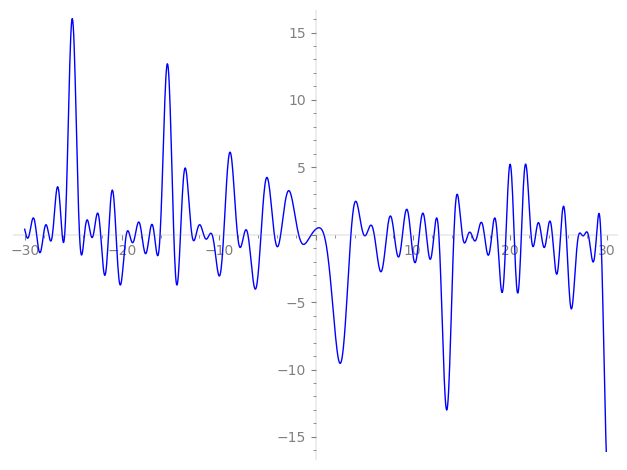| L(s) = 1 | + (−0.707 − 1.22i)2-s + (−2.41 − 1.39i)3-s + (−0.999 + 1.73i)4-s + (−2.74 + 1.58i)5-s + 3.94i·6-s + (0.710 − 2.54i)7-s + 2.82·8-s + (2.39 + 4.15i)9-s + (3.88 + 2.24i)10-s + (4.83 − 2.79i)12-s + 3.60i·13-s + (−3.62 + 0.931i)14-s + 8.84·15-s + (−2.00 − 3.46i)16-s + (5.61 + 3.24i)17-s + (3.38 − 5.87i)18-s + ⋯ |
| L(s) = 1 | + (−0.499 − 0.866i)2-s + (−1.39 − 0.805i)3-s + (−0.499 + 0.866i)4-s + (−1.22 + 0.708i)5-s + 1.61i·6-s + (0.268 − 0.963i)7-s + 0.999·8-s + (0.798 + 1.38i)9-s + (1.22 + 0.708i)10-s + (1.39 − 0.805i)12-s + 0.999i·13-s + (−0.968 + 0.248i)14-s + 2.28·15-s + (−0.500 − 0.866i)16-s + (1.36 + 0.786i)17-s + (0.798 − 1.38i)18-s + ⋯ |
Λ(s)=(=(728s/2ΓC(s)L(s)(−0.620+0.784i)Λ(2−s)
Λ(s)=(=(728s/2ΓC(s+1/2)L(s)(−0.620+0.784i)Λ(1−s)
| Degree: |
2 |
| Conductor: |
728
= 23⋅7⋅13
|
| Sign: |
−0.620+0.784i
|
| Analytic conductor: |
5.81310 |
| Root analytic conductor: |
2.41103 |
| Motivic weight: |
1 |
| Rational: |
no |
| Arithmetic: |
yes |
| Character: |
χ728(675,⋅)
|
| Primitive: |
yes
|
| Self-dual: |
no
|
| Analytic rank: |
0
|
| Selberg data: |
(2, 728, ( :1/2), −0.620+0.784i)
|
Particular Values
| L(1) |
≈ |
0.175380−0.362174i |
| L(21) |
≈ |
0.175380−0.362174i |
| L(23) |
|
not available |
| L(1) |
|
not available |
L(s)=p∏Fp(p−s)−1 | p | Fp(T) |
|---|
| bad | 2 | 1+(0.707+1.22i)T |
| 7 | 1+(−0.710+2.54i)T |
| 13 | 1−3.60iT |
| good | 3 | 1+(2.41+1.39i)T+(1.5+2.59i)T2 |
| 5 | 1+(2.74−1.58i)T+(2.5−4.33i)T2 |
| 11 | 1+(5.5+9.52i)T2 |
| 17 | 1+(−5.61−3.24i)T+(8.5+14.7i)T2 |
| 19 | 1+(−9.5+16.4i)T2 |
| 23 | 1+(11.5−19.9i)T2 |
| 29 | 1−29T2 |
| 31 | 1+(9.48+5.47i)T+(15.5+26.8i)T2 |
| 37 | 1+(5.06+8.76i)T+(−18.5+32.0i)T2 |
| 41 | 1+41T2 |
| 43 | 1−13.1T+43T2 |
| 47 | 1+(2.34−1.35i)T+(23.5−40.7i)T2 |
| 53 | 1+(26.5+45.8i)T2 |
| 59 | 1+(−29.5−51.0i)T2 |
| 61 | 1+(−30.5+52.8i)T2 |
| 67 | 1+(33.5+58.0i)T2 |
| 71 | 1−15.7T+71T2 |
| 73 | 1+(−36.5−63.2i)T2 |
| 79 | 1+(39.5−68.4i)T2 |
| 83 | 1+83T2 |
| 89 | 1+(−44.5+77.0i)T2 |
| 97 | 1+97T2 |
| show more | |
| show less | |
L(s)=p∏ j=1∏2(1−αj,pp−s)−1
Imaginary part of the first few zeros on the critical line
−10.68041190942427509803948030651, −9.486613400494767032136238800714, −8.063669915299760872325666110571, −7.39878825323980076821745352622, −6.98897136947671177415222251097, −5.64201355244744292916018676958, −4.26351809838524161211604088700, −3.61344301492177075435747829750, −1.75774673889826632871080382800, −0.45829451794364199343323664764,
0.849486795646886939645714661023, 3.62697820487122897670744888853, 4.94627667959251472910048633083, 5.20143329358368631194174233318, 6.03255250347620464395119594944, 7.31697855354850006980722452295, 8.091607957025637178421662561060, 8.943676678921623024166771633497, 9.799579724458806372625686435682, 10.67375261011096382397958325951

